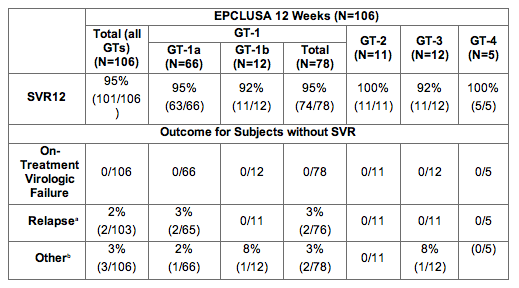| |
Revisions to the Epclusa Label Approved/ Coinfection Approval
|
| |
| |
Today, August 1, 2017, FDA approved revisions to the Epclusa (sofosbuvir/velpatasvir) label to include information from adult patients co-infected with chronic hepatitis C virus infection and HIV-1 infection based upon the data from the ASTRAL-5 clinical trial.
The major changes include the following:
Section 2: DOSAGE AND ADMINISTRATION:
2.2 Recommended Dosage
The recommended dosage of EPCLUSA is one tablet taken orally once daily with or without food [see Clinical Pharmacology (12.3)]. One tablet of EPCLUSA contains 400 mg of sofosbuvir and 100 mg of velpatasvir. Table 1 shows the recommended treatment regimen and duration based on patient population.
For patients with HCV/HIV-1 co-infection, follow the dosage recommendations in Table 1 [see Clinical Studies (14.3)]. Refer to Drug Interactions (7) for dosage recommendations for concomitant HIV-1 antiviral drugs.

a In clinical trials, regimens contained peginterferon alfa/ribavirin with or without an HCV NS3/4A protease inhibitor (boceprevir, simeprevir, or telaprevir).
b When administered with EPCLUSA, the recommended dosage of ribavirin is based on weight (administered with food): 1000 mg per day for patients less than 75 kg and 1200 mg for those weighing at least 75 kg, divided and administered twice daily. The starting dosage and on-treatment dosage of ribavirin can be decreased based on hemoglobin and creatinine clearance. For ribavirin dosage modifications, refer to the ribavirin prescribing information.
Section 6: ADVERSE REACTIONS updated to include the safety findings from ASTRAL-5 along with post-marketing experience
Adverse Reactions in Subjects Coinfected with HCV and HIV-1
The safety assessment of EPCLUSA in subjects with HCV/HIV-1 co-infection was based on an open-label clinical trial (ASTRAL-5) in 106 subjects who were on stable antiretroviral therapy [see Clinical Studies (14.3)]. The safety profile in HCV/HIV-1
coinfected subjects was similar to that observed in HCV mono-infected subjects. The most common adverse reactions occurring in at least 10% of subjects were fatigue (22%) and headache (10%).
6.2 Postmarketing Experience
The following adverse reactions have been identified during post approval use of sofosbuvir. Because post-marketing reactions are reported voluntarily from a population of uncertain size, it is not always possible to reliably estimate their frequency or establish a causal relationship to drug exposure.
Skin and Subcutaneous Tissue Disorders updated to include: Skin rashes, sometimes with blisters or angioedema-like swelling
Section 14: CLINICAL STUDIES updated to include the efficacy results from ASTRAL-5 as follows
14.3 Clinical Trial in Subjects Coinfected with HCV and HIV-1
ASTRAL-5 was an open-label trial that evaluated 12 weeks of treatment with EPCLUSA in subjects with genotype 1, 2, 3, 4, 5 or 6 HCV infection who were co-infected with HIV-1. Subjects were on a stable HIV-1 antiretroviral therapy that included emtricitabine/tenofovir disoproxil fumarate or abacavir/lamivudine administered with atazanavir/ritonavir, darunavir/ritonavir, lopinavir/ritonavir, rilpivirine, raltegravir or elvitegravir/cobicistat.
Of the 106 treated subjects, the median age was 57 years (range: 25 to 72); 86% of the subjects were male; 51% were White; 45% were Black; 22% had a baseline body mass index at least 30 kg/m2; the proportions of patients with genotype 1, 2, 3, or 4 HCV infection were 74%; 10%; 11%, and 5% respectively; no subjects with genotype 5 or 6 HCV were treated with EPCLUSA; 77% had non- CC IL28B alleles (CT or TT); 74% had baseline HCV RNA levels of at least 800,000 IU/mL; 18% had compensated cirrhosis; and 29% were treatment experienced. The overall mean CD4+ count was 598 cells/μL (range: 183-1513 cells/μL) and 57% of subjects had CD4+ counts > 500 cells/μL.
Table 14 presents the SVR12 for the ASTRAL-5 trial by HCV genotype.

a The denominator for relapse is the number of subjects with HCV RNA < LLOQ at their last on-treatment assessment.
b Other includes subjects who did not achieve SVR and did not meet virologic failure criteria.
No subject had HIV-1 rebound during treatment and CD4+ counts were stable during treatment.
The updated labels will soon be available drugs@fda or DailyMed
Steve Morin
Office of Health and Constituent Affairs
Food and Drug Administration
Richard Klein
Office of Health and Constituent Affairs
Food and Drug Administration
Kimberly Struble
Division of Antiviral Products
Food and Drug Administration
|
|
| |
| |
|
|
|